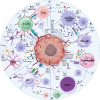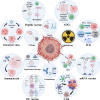Understanding the immunosuppressive microenvironment of glioma: mechanistic insights and clinical perspectives
- PMID: 38720342
- PMCID: PMC11077829
- DOI: 10.1186/s13045-024-01544-7
Understanding the immunosuppressive microenvironment of glioma: mechanistic insights and clinical perspectives
Abstract
Glioblastoma (GBM), the predominant and primary malignant intracranial tumor, poses a formidable challenge due to its immunosuppressive microenvironment, thereby confounding conventional therapeutic interventions. Despite the established treatment regimen comprising surgical intervention, radiotherapy, temozolomide administration, and the exploration of emerging modalities such as immunotherapy and integration of medicine and engineering technology therapy, the efficacy of these approaches remains constrained, resulting in suboptimal prognostic outcomes. In recent years, intensive scrutiny of the inhibitory and immunosuppressive milieu within GBM has underscored the significance of cellular constituents of the GBM microenvironment and their interactions with malignant cells and neurons. Novel immune and targeted therapy strategies have emerged, offering promising avenues for advancing GBM treatment. One pivotal mechanism orchestrating immunosuppression in GBM involves the aggregation of myeloid-derived suppressor cells (MDSCs), glioma-associated macrophage/microglia (GAM), and regulatory T cells (Tregs). Among these, MDSCs, though constituting a minority (4-8%) of CD45+ cells in GBM, play a central component in fostering immune evasion and propelling tumor progression, angiogenesis, invasion, and metastasis. MDSCs deploy intricate immunosuppressive mechanisms that adapt to the dynamic tumor microenvironment (TME). Understanding the interplay between GBM and MDSCs provides a compelling basis for therapeutic interventions. This review seeks to elucidate the immune regulatory mechanisms inherent in the GBM microenvironment, explore existing therapeutic targets, and consolidate recent insights into MDSC induction and their contribution to GBM immunosuppression. Additionally, the review comprehensively surveys ongoing clinical trials and potential treatment strategies, envisioning a future where targeting MDSCs could reshape the immune landscape of GBM. Through the synergistic integration of immunotherapy with other therapeutic modalities, this approach can establish a multidisciplinary, multi-target paradigm, ultimately improving the prognosis and quality of life in patients with GBM.
© 2024. The Author(s).
Conflict of interest statement
The authors declare that they have no competing interests.
Figures








Similar articles
-
Immature myeloid cells in the tumor microenvironment: Implications for immunotherapy.Clin Immunol. 2018 Apr;189:34-42. doi: 10.1016/j.clim.2016.10.008. Epub 2016 Oct 21. Clin Immunol. 2018. PMID: 27777083 Free PMC article. Review.
-
FGL2172-220 peptides improve the antitumor effect of HCMV-IE1mut vaccine against glioblastoma by modulating immunosuppressive cells in the tumor microenvironment.Oncoimmunology. 2024 Dec 31;13(1):2423983. doi: 10.1080/2162402X.2024.2423983. Epub 2024 Nov 6. Oncoimmunology. 2024. PMID: 39508842 Free PMC article.
-
Immunosuppressive Myeloid Cells' Blockade in the Glioma Microenvironment Enhances the Efficacy of Immune-Stimulatory Gene Therapy.Mol Ther. 2017 Jan 4;25(1):232-248. doi: 10.1016/j.ymthe.2016.10.003. Epub 2017 Jan 4. Mol Ther. 2017. PMID: 28129117 Free PMC article.
-
Harnessing innate immunity against glioblastoma microenvironment.Front Immunol. 2025 Jul 25;16:1648601. doi: 10.3389/fimmu.2025.1648601. eCollection 2025. Front Immunol. 2025. PMID: 40787444 Free PMC article. Review.
-
Glioblastoma Myeloid-Derived Suppressor Cell Subsets Express Differential Macrophage Migration Inhibitory Factor Receptor Profiles That Can Be Targeted to Reduce Immune Suppression.Front Immunol. 2020 Jun 18;11:1191. doi: 10.3389/fimmu.2020.01191. eCollection 2020. Front Immunol. 2020. PMID: 32625208 Free PMC article.
Cited by
-
Personalized mRNA vaccines in glioblastoma therapy: from rational design to clinical trials.J Nanobiotechnology. 2024 Oct 4;22(1):601. doi: 10.1186/s12951-024-02882-x. J Nanobiotechnology. 2024. PMID: 39367418 Free PMC article. Review.
-
The Immunomodulatory Effects of Vitamin D on COVID-19 Induced Glioblastoma Recurrence via the PI3K-AKT Signaling Pathway.Int J Mol Sci. 2024 Dec 2;25(23):12952. doi: 10.3390/ijms252312952. Int J Mol Sci. 2024. PMID: 39684661 Free PMC article.
-
Mucins as Precision Biomarkers in Glioma: Emerging Evidence for Their Potential in Biospecimen Analysis and Outcome Prediction.Biomedicines. 2024 Dec 11;12(12):2806. doi: 10.3390/biomedicines12122806. Biomedicines. 2024. PMID: 39767713 Free PMC article. Review.
-
The comprehensive potential of AQP1 as a tumor biomarker: evidence from kidney neoplasm cohorts, cell experiments and pan-cancer analysis.Hum Genomics. 2025 Feb 23;19(1):15. doi: 10.1186/s40246-025-00726-9. Hum Genomics. 2025. PMID: 39988693 Free PMC article.
-
ARHGDIB as a prognostic biomarker and modulator of the immunosuppressive microenvironment in glioma.Cancer Immunol Immunother. 2025 May 15;74(7):204. doi: 10.1007/s00262-025-04063-7. Cancer Immunol Immunother. 2025. PMID: 40372473 Free PMC article.
References
-
- Qazi MA, Vora P, Venugopal C, Sidhu SS, Moffat J, Swanton C, et al. Intratumoral heterogeneity: pathways to treatment resistance and relapse in human glioblastoma. Ann Oncol. 2017;28(7):1448–1456. - PubMed
Publication types
MeSH terms
Grants and funding
LinkOut - more resources
Full Text Sources
Medical
Research Materials
Miscellaneous

